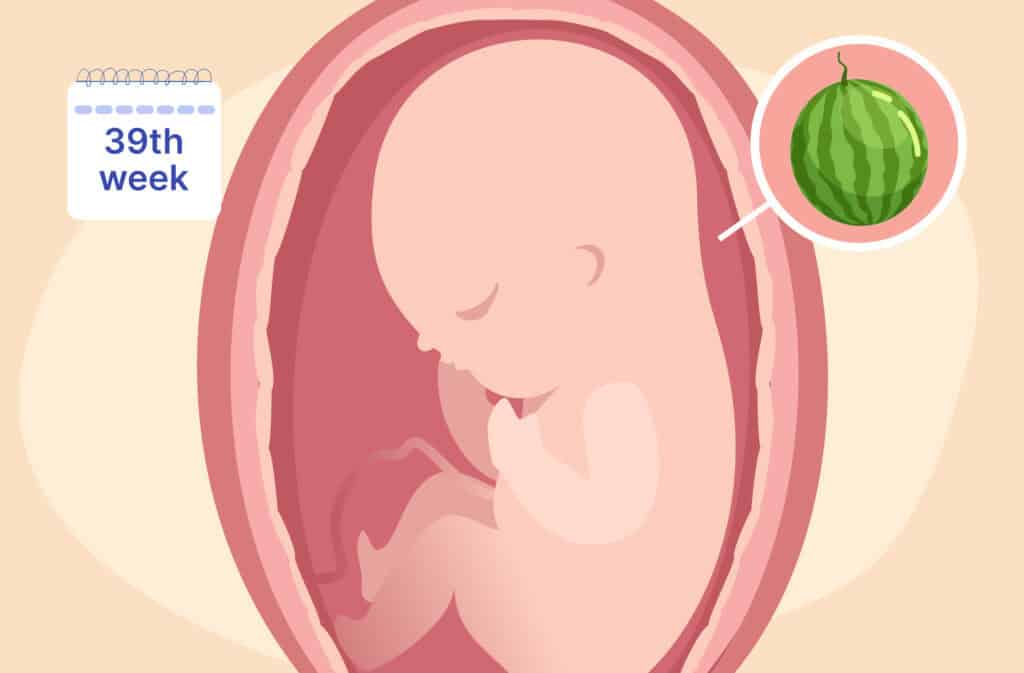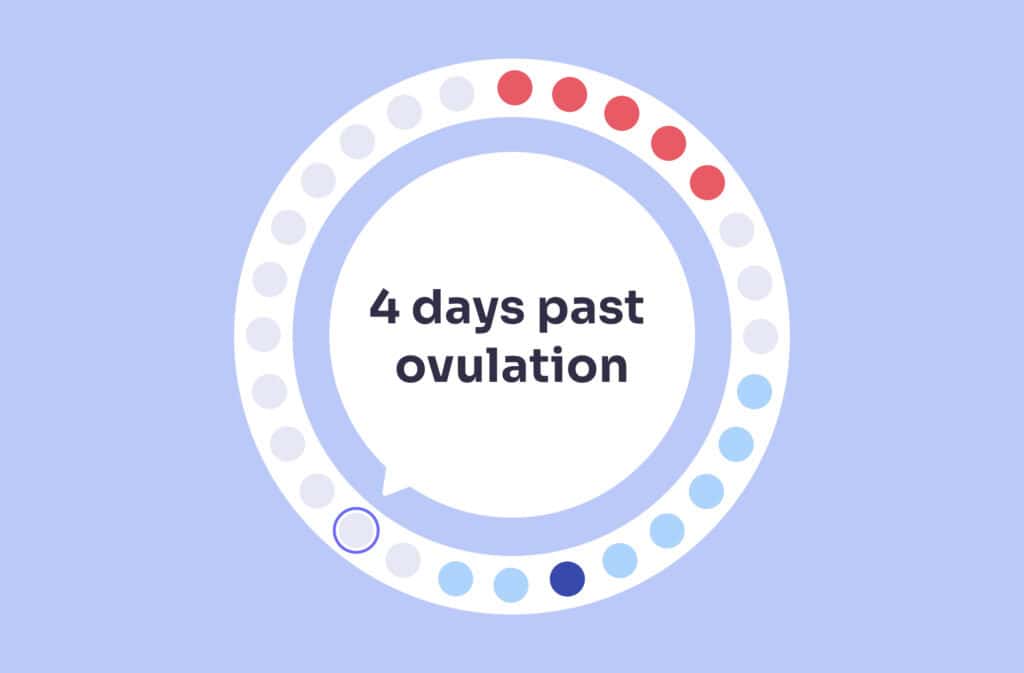Femia > Health Library > Pregnancy > Pregnancy week by week > 39 Weeks pregnant: Discharge, spotting & birth readiness
39 Weeks pregnant: Discharge, spotting & birth readiness

- Updated Feb 14, 2025
- Published
CRAFTED BY HUMAN
Crafted by human At Femia, we provide accurate and up-to-date information at every stage of your journey, from trying to conceive, pregnancy and postnatal support. All content is created by a real person based on in-depth research and own professional experience. Femia ensures that you will receive expert advice, strict accuracy and a personalized approach from our authors/medical experts. Learn more about our editorial policy.
FACT CHECKED
Fact checked At Femia Health, we maintain the highest standards of editorial excellence in delivering content focused on helping you conceive, guiding you through pregnancy, and supporting you postpartum. Explore our content review principles to learn how we ensure the accuracy and quality of our health and lifestyle tips for every stage of your journey.

Created with Hector Chapa, MD, FACOG, Clinical associate professor, Obstetrics and Gynecology Texas A&M University, College of Medicine in Bryan-College Station, USA
- At 39 weeks pregnant, you are now called full term and your baby is ready to meet the world. At this stage, your baby is considered full-term and weighs approximately 3.2 kilograms (7 pounds), measuring about 20 inches long.
- Watch for labor signs, manage back pain, and prepare mentally for delivery while staying alert to symptoms like spotting or changes in discharge.
- The labor signs to watch for: regular, intense contractions, water breaking, losing y, and lower back pain.
You’ve made it to 39 weeks pregnant—your baby’s due date is just around the corner, which is 40 weeks! While some women experience labor symptoms, others may not yet see signs of labor. Let’s explore week 39 of pregnancy, including labor signs, symptoms, and tips for managing anxiety as you prepare for delivery.
Join thousands of moms-to-be who trust Femia for expert-backed
guidance during pregnancy and beyond
Pregnancy symptoms at 39 weeks
Here are common symptoms you may experience at 39 weeks:
Baby kicks
Keep monitoring your baby’s movements, and immediately contact your healthcare provider if you notice a decrease. It’s normal for movements to slow as your baby grows, but a noticeable decrease could signal a problem.
Cervical changes
During a prenatal checkup, your provider might check your cervix to see if it has begun to ripen (softening, thinning, or dilating). However, this doesn’t predict when labor will start, as some women progress quickly, while others may take longer.
Leaking fluid
If you think your water has broken, contact your provider right away. Leaking amniotic fluid could indicate your water has ruptured, and while contractions may not start immediately, it’s important to monitor for potential infection risks.
Breast leaking
At 39 weeks, you may notice your breasts leaking colostrum, a nutrient-rich fluid that will feed your baby after birth. It’s a natural part of preparing for breastfeeding.
Diarrhea
Diarrhea can sometimes occur as your body prepares for labor, but it doesn’t necessarily mean labor is imminent. If accompanied by other symptoms, or if it persists for more than a couple of days, consult your healthcare provider.
Pelvic pain
Pelvic pain is common at 39 weeks as your body supports a full-term baby. Resting, limiting strenuous activities, and asking for help can alleviate discomfort. If pain worsens or is severe, consult your provider to rule out complications.
Mood swings
Hormonal fluctuations in the final weeks can cause mood swings. If feelings of sadness, anxiety, or depression persist, contact your provider for support and guidance.
Sudden decrease in baby movements
You may notice changes in vaginal discharge, such as increased mucus-like discharge or “bloody show.” This is a normal sign that labor may be near. If the discharge is unusual or accompanied by other symptoms, consult your healthcare provider.
👉Find out more: 38 Weeks pregnant: Labor readiness & emotional support
Symptoms not to ignore at 39 weeks
- Heavy bleeding. Bright red bleeding at 39 weeks pregnant is not typical and could signal a complication, such as placental abruption or placenta previa, where the placenta detaches or is positioned abnormally. Both conditions can endanger both mother and baby, and immediate medical attention is necessary. If you experience heavy bleeding, contact your provider right away.
- Reduced baby movements. A significant decrease in fetal movement can indicate distress, including issues with the placenta or umbilical cord, or potential fetal compromise. If you notice a noticeable drop in activity or can’t feel the typical movements, contact your healthcare provider immediately. Monitoring baby’s movement patterns is crucial during the final weeks of pregnancy.
- Severe back pain. Persistent, intense back pain, particularly if it feels different from the usual discomfort of pregnancy, could be a sign of back labor, a form of labor pain caused by the baby’s position. This type of pain can be more severe and might accompany other signs of labor. If the pain becomes unbearable or doesn’t subside with rest, contact your doctor or midwife for guidance on pain management and to rule out other potential issues.
- Frequent, painful contractions. Regular contractions that are painful and increase in intensity may indicate the start of labor. If contractions are coming at intervals of 5 minutes or less, lasting about a minute each, it’s time to head to your birth facility. Even if the contractions are irregular but consistently painful, it’s essential to get checked out to assess cervical changes and confirm if labor is progressing.
- Watery vaginal discharge. If your vaginal discharge becomes watery, it may indicate that your water has broken. This is the rupture of the amniotic sac, which protects and cushions your baby. If your water breaks but labor doesn’t start soon after, you’re at a higher risk for infection, and your healthcare provider may need to induce labor. Contact your provider immediately to confirm if your water has broken and discuss the next steps.
Your body at 39 weeks pregnant
At 39 weeks pregnant, your body is fully prepared for delivery. As your baby moves lower into your pelvis in preparation for birth, you may experience increased pelvic pressure, making it harder to walk or sit comfortably. Your center of gravity shifts, and this added pressure on your pelvic floor can cause discomfort, especially when you try to change positions. You might also feel more fatigued as your body works hard to support the growing baby and get ready for labor.
Along with the physical pressure, Braxton Hicks contractions may become more frequent and intense. These “practice” contractions can help tone the muscles in your uterus, preparing them for labor. While Braxton Hicks are typically irregular and not painful, they can feel more noticeable as your body gets closer to delivery. Resting and staying hydrated can help alleviate these contractions. However, if they become regular, painful, or accompanied by other signs of labor, it’s important to seek medical advice.
39 Weeks pregnant belly
Your belly will feel heavy, and the baby’s movements may feel slower but stronger as space becomes limited. Stretch marks and skin tightness are common due to your bump’s size.
Baby development at 39 weeks
At 39 weeks, your baby is considered full-term, with all major organs and systems fully developed and functioning. The lungs are fully matured, and they are continuing to practice important life skills like breathing, sucking, and gripping. These essential skills will help them adjust to life outside the womb after birth.
Your baby is also gaining fat to help regulate their body temperature once born. While most of their physical development is complete, they are still putting on weight, which is important for energy stores after birth. This extra fat helps keep them warm and supports their growth and development in the first few months of life.
Baby at 39 weeks
- Weight: About 3.2 kilograms (7 pounds)
- Length: Approximately 20 inches, about the size of a mini watermelon
- Movements: As space becomes more limited in the womb, you may feel less frequent but stronger kicks, stretches, and rolls.
While your baby’s movements may feel less pronounced now due to limited space, they should still remain active. Pay attention to their movement patterns and consult your healthcare provider if you notice any significant changes. At this stage, your baby is ready for delivery, and labor could begin anytime.
39-Week ultrasound
A 39-week ultrasound may be recommended if you’re experiencing complications or to check your baby’s position and amniotic fluid levels.
Join thousands of moms-to-be who trust Femia for expert-backed
guidance during pregnancy and beyond
Signs of labor at 39 weeks
Here are signs that labor may be near:
- Losing your mucus plug: This jelly-like discharge often tinged with blood is a sign your cervix is dilating.
- Regular, painful contractions: These contractions grow closer together and more intense over time.
- Water breaking: A sudden gush or slow trickle of fluid signals that labor has begun.
- Lower back pain: Persistent, intense back pain may be a sign of back labor.
If you’re unsure whether you’re in labor, contact your healthcare provider.
👉Find out more: 40 Weeks pregnant: Full-term baby, symptoms, and delivery prep
Health tips and self-care at 39 weeks pregnant
At 39 weeks pregnant, your body is working hard to prepare for labor and delivery. Self-care is essential during this time to ensure both your well-being and your baby’s health. Here are some tips to help you navigate the final weeks of pregnancy:
Stay active and rest when needed
While it’s important to stay active, especially to keep your body ready for labor, don’t forget to rest when you need it. Gentle walks or light stretching can help relieve discomfort and improve circulation. At the same time, be mindful of your body’s signals and rest whenever you feel fatigued or experience pelvic pressure.
Hydrate and nourish your body
Drinking plenty of water helps to reduce swelling and keep you hydrated. Focus on a balanced diet with plenty of whole grains, protein, fruits, and vegetables to fuel your body. Eating small, frequent meals can help manage heartburn and provide consistent energy as you approach labor.
Practice relaxation techniques
As your due date approaches, it can be helpful to practice relaxation techniques such as deep breathing, meditation, or prenatal yoga. These practices can reduce stress, ease discomfort, and prepare your body for labor. Visualizing the birth process and focusing on the positive aspects of delivery can help you feel more confident and calm.
Shop for postpartum essentials
Now is a great time to get your postpartum essentials ready. Stock up on items such as maternity pads, nipple cream, nursing bras, and comfortable clothing for after the birth. Don’t forget about baby items such as diapers, wipes, and baby clothes. Having these items on hand will help you focus on your baby once they arrive.
Prepare for baby feeding
If you plan to breastfeed, preparing for baby feeding in advance can make the transition smoother. Consider talking to a lactation consultant for guidance on breastfeeding techniques. You may also want to familiarize yourself with nursing positions and stock up on breastfeeding supplies like nursing pads, a pump, and bottles if needed.
Monitor baby's movements
Keep track of your baby’s movements throughout the day. While movements may become less pronounced as they run out of space, it’s important that your baby is still active. If you notice a significant decrease in movements, contact your healthcare provider immediately.
By staying proactive with self-care and preparing for postpartum, you are ensuring that you’re as ready as possible for the arrival of your baby. Make sure to keep communication open with your healthcare provider, ask questions about labor, and stay calm as you approach the big day!
Questions from the Femia community
How many days should I stay in the hospital?
The typical hospital stay for a vaginal delivery is 1-2 days, while a C-section may require 2-3 days. This can vary depending on your recovery and your baby’s health. Discuss your specific needs with your provider before delivery.
How to deal with delivery anxiety?
Delivery anxiety is common and can be managed through preparation and relaxation techniques. Educate yourself about the labor process, create a flexible birth plan, and talk to your partner or provider about your concerns. Breathing exercises, meditation, and positive affirmations can also help reduce stress.
Is gas a sign of labor at 39 weeks?
Gas or bloating isn’t a definitive sign of labor, but it can be caused by hormonal changes or digestive shifts as your baby moves lower into the pelvis. If accompanied by regular contractions or back pain, it may indicate labor is near.
What should I do if I’ve lost my mucus plug but have no contractions?
Losing your mucus plug is a sign that labor may begin soon, but it doesn’t mean it will start immediately. Continue monitoring for other labor signs like contractions or water breaking, and contact your provider if you have concerns.
What can go wrong at 39 weeks pregnant?
At 39 weeks, some complications to watch for include preeclampsia, reduced fetal movement, severe back pain, and heavy bleeding. It's important to monitor for symptoms like regular painful contractions, sudden changes in vaginal discharge, or severe headaches, as these could indicate a more serious issue and require immediate medical attention.
How soon after loose bowels did you go into labor?
Loose bowels or diarrhea in late pregnancy can be a sign of labor starting, as the body prepares for delivery. However, there’s no set time frame for when labor will follow. Some women may experience this symptom hours before labor, while others may not experience it at all. It's always best to monitor for other signs like regular contractions.
The bottom line
At 39 weeks, your baby is fully developed and ready for birth. While you may notice symptoms like pelvic pressure, back pain, or increased discharge, labor signs such as regular contractions, water breaking, or losing your mucus plug are key indicators that delivery is near. However, it’s normal for some women not to experience any labor signs at this stage.
It’s essential to stay attentive to your symptoms, especially if you notice reduced baby movements or unusual spotting, and promptly inform your healthcare provider. Use this time to finalize your birth plan, prepare your hospital bag, and ensure all practical arrangements are in place. Managing discomfort with light activity, hydration, and rest can help you conserve energy for labor. Regular communication with your provider will ensure both you and your baby are ready for the upcoming delivery.
References
- “39 Weeks Pregnant: Symptoms, Baby Development & Tips.” BabyCenter, www.babycenter.com/pregnancy/week-by-week/39-weeks-pregnant.
- “Week 39 of Pregnancy: Symptoms, Baby Development & More.” What to Expect, www.whattoexpect.com/pregnancy/week-by-week/week-39.aspx.
- “39 Weeks Pregnant: Baby Development, Symptoms & Tips.” NHS, www.nhs.uk/pregnancy/week-by-week/1-to-12/39-weeks/.
- “Pregnancy Week 39: What to Expect.” American Pregnancy Association, www.americanpregnancy.org/healthy-pregnancy/week-by-week/39-weeks-pregnant/.

Understand what happens at 4 days past ovulation (4 DPO), including common pregnancy symptoms and when to take a pregnancy test. Expert advice from Femia.

Let’s learn what is postpartum hair loss, why it happens, and how you can manage the process.

The 5-5-5 rule is a simple guideline for the first 15 days postpartum which can help with recovery following childbirth. It encourages intentional rest while bonding with your baby.
